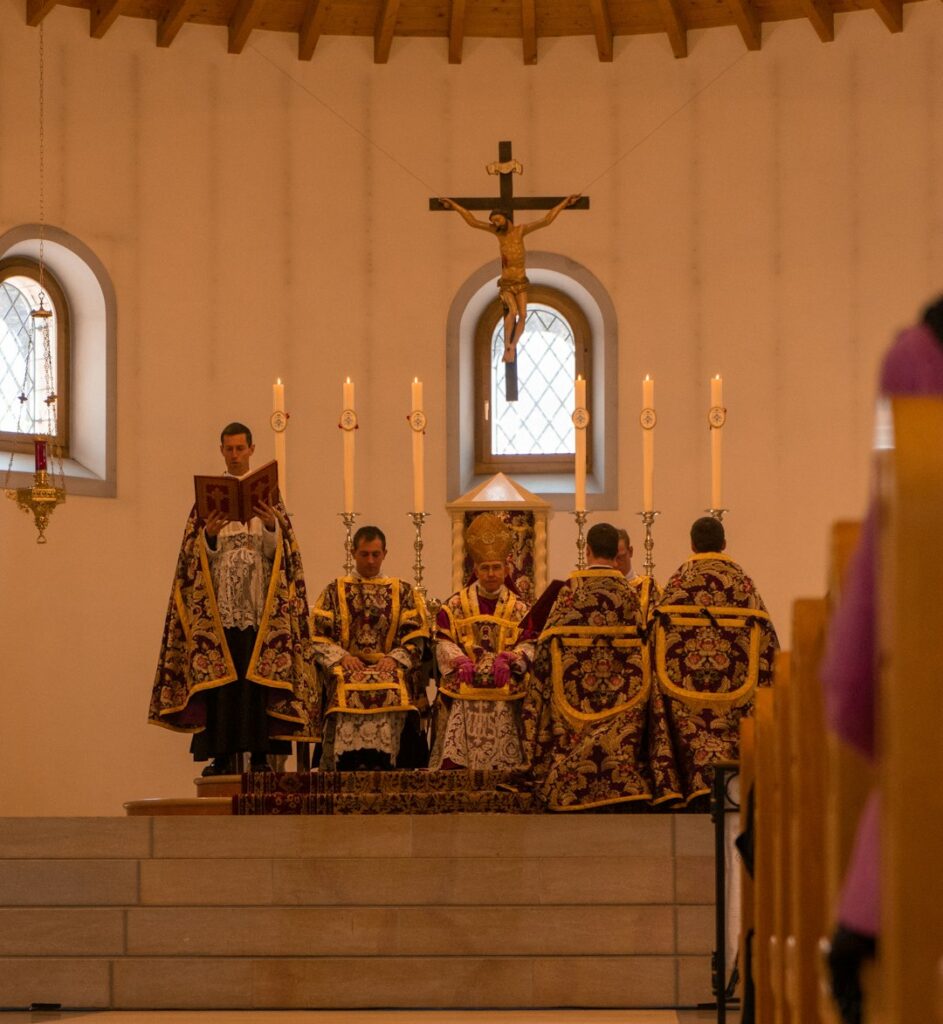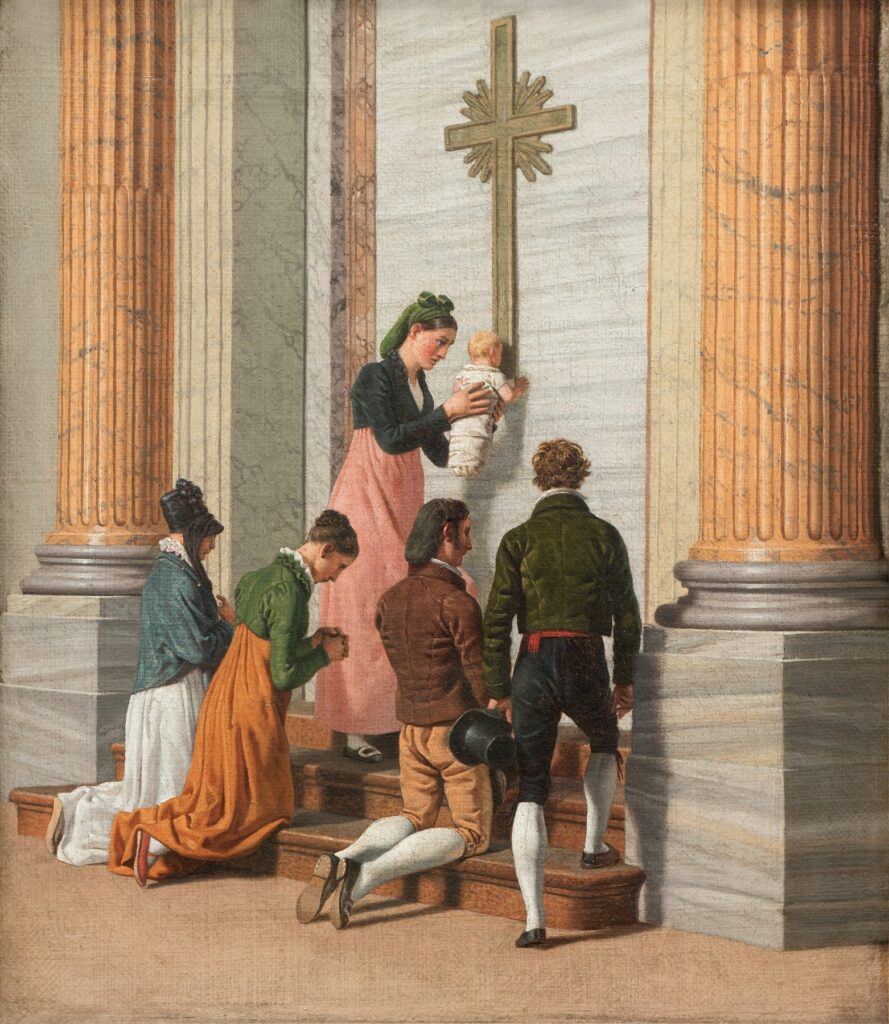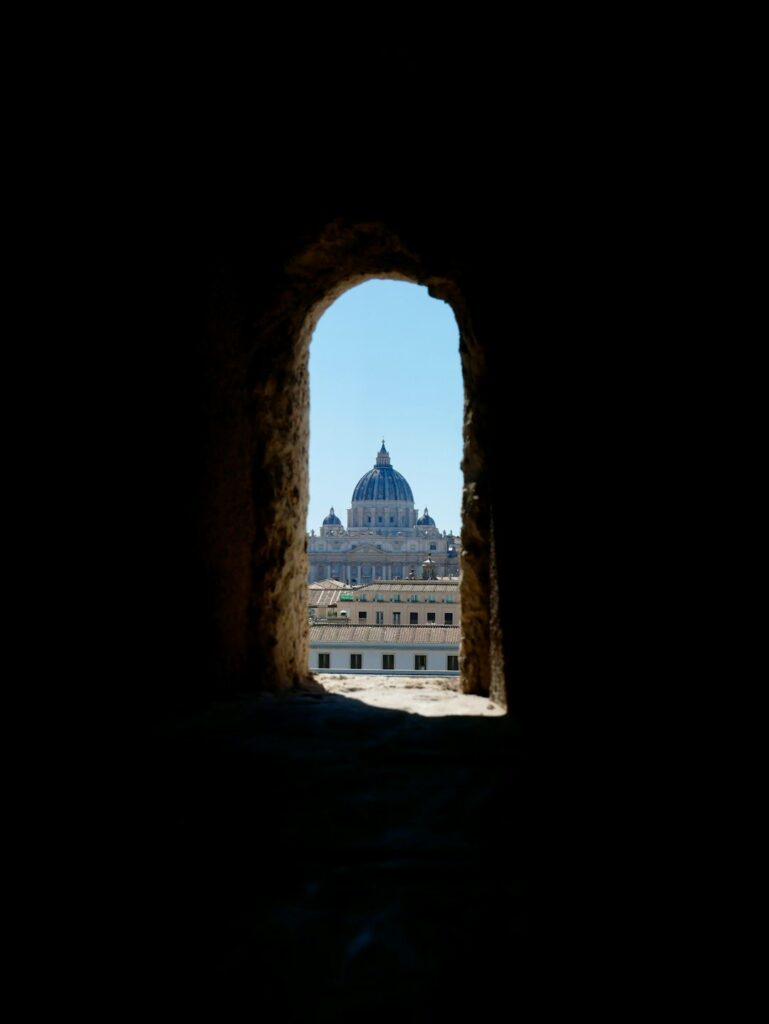In his closing discourse to the Second Vatican Council, Pope Paul VI pointed out that the Council had not been occupied so much with divine truths as with the nature and composition of the Church, who had ‘endeavoured to carry out an act of reflection about herself, to know herself better, to define herself better’.[1] Reading these words of one of the principal architects of the Council and the ultimate authority behind its documents, one would expect to find in the Council a most perfect definition of the Church, one that precludes any confusion or dispute. After 2,000 years of existence, one would hope that the Church would know who She is and what She is about, especially considering that Paul VI had the input of all the world’s bishops over a period of three years of discussions and debates. A most perspicuous vision of the Church was to be expected. Is this what we got?
As subsequent years and decades have shown, we must admit that the image of the Church given to us by the Council, far from clarifying her ‘nature and composition’, has led to a great deal of confusion about what and who She really is and what She is supposed to be doing. Last month, we examined the orientation complex created by the turning around of the altars in our churches. This month, we intend to consider another kind of disorientation, which we can only call an identity complex, and which stems directly from the Council itself.
Whose People?
One of the most well-known expressions of Vatican II is that the Church is the ‘People of God’. What could be more scriptural? In the Old Testament, Israel was God’s chosen people, the one He loved and to whom He revealed Himself. The Israel of the New Testament is the Church, founded by Christ. It therefore makes sense to refer to her as the People of God. What is curious, however, is that this concept was not particularly favoured in the traditional writings of the saints and doctors. As recently as 1943, Pius XII had written a magnificent encyclical on the Church entitled Mystici Corporis Christi, which was based on St Paul’s teaching to the Corinthians in which he compares the Church to a body, each member of which is important and must play its particular role, but which does not even mention the expression ‘People of God’ (cf. 1 Cor 12).
One plausible reason for this is that the term is open to equivocation. Did not God create all people? If so, then are not all people God’s People? Is there anyone who is not part of God’s people? It is perfectly legitimate to ask whether the choice of the expression was not determined precisely by the desire to include all people in the Church. Indeed, at the time of the Council, Karl Rahner’s theory of the ‘anonymous Christian’ was very much in vogue. The wishful thinking of this most influential of theologians of the last century led many to believe that, whether they realise it or not, most people are actually part of God’s People (including atheists by the way).
Another curious aspect of the Dogmatic Constitution on the Church given to us by the Council, Lumen Gentium, is the order of its chapters. After an initial chapter on the Mystery of the Church comes one on the People of God. Only in third position comes that ‘on the hierarchical constitution of the Church, and in particular, the episcopate’. This gives the impression that the Church exists first as a group of people, and that since every group needs some kind of guidance, Christ decided to provide it with a priestly hierarchy.
One of the most obvious problems with this thinking is that this does not correspond at all with the reality as presented to us by the New Testament, in which we read that the Lord began by choosing disciples whom He made His priests and ministers. At the beginning, the Church was only a group of priests. The hierarchy comes first in time, and it is to this hierarchy that the preaching of the faith and the administration of the sacraments are entrusted. While it may seem pedantic at first sight to state this obvious fact, it has far-reaching consequences. It means that there can be no Church without a hierarchy, a sacramental hierarchy exactly as Christ established it; not even the priests themselves can adapt and change this divine constitution of the Church as they see fit. A family does not begin with a group of people; it begins with parents who bring the children into existence. So, the Church begins with the priests, whose task it is to impart the faith to all others through the preaching of the Gospel and the administration of the sacraments. This in no way diminishes the dignity of every baptised member of the Church. However, it does raise a certain confusion about the role of the priesthood. The present-day confusion surrounding the concept of a ‘synodal Church’ seems to stem directly from the insistence on the Church as the People of God.

Would all the confusion regarding the essence of the Church today be possible had we still been working with the Mystical Body theology so well described by Pius XII? It’s a valid question. Indeed, the image of the body clearly shows that while all members are united for one purpose, the members do not possess the same role or dignity. Hands and feet are essential to the body, but they are neither the heart nor the head nor any of the vital organs. Whereas, if you are working with a People of God model in a democratic society, this means that any individual can assume any role of governance if they put their mind to it. Not so in a body. The best hand will never be the heart. The best foot will never be the head. This would destroy the unity of the body. But it would seem that the Council intentionally chose this ambiguity in order to allow for other forms of ‘being church’.
Who is ‘the Church’?
Upon closer examination, however, of Lumen Gentium, we perceive that there are other, even greater problems. The two words in the constitution on the Church that have caused the most ink to flow are found in paragraph 8, where we learn that the Church of Christ ‘subsists in’ the Catholic Church. While Pope Pius XII, just 20 years earlier, unequivocally stated that the true Church of Jesus is the One, Holy, Catholic, Apostolic and Roman Church,[2] the Fathers of Vatican II chose to avoid identifying the true Church with the Catholic Church. Why was this? The main reason seems to be due to the words that follow: ‘many elements of sanctification and of truth are found outside of its visible structure’.[3]
In other words, a ‘pastoral’ approach superseded the dogmatic one. The aim was ecumenism, and so a door had to be left open so that Christian denominations other than the Catholic Church could be considered part of the Church of Christ without denying that the Catholic Church has all the elements that Christ gave to His Church. That this is the case is demonstrated by what we find in the council’s decree on ecumenism, Unitatis redintegratio. There we can read that ‘the separated Churches and Communities as such, though we believe them to be deficient in some respects, have been by no means deprived of significance and importance in the mystery of salvation. For the Spirit of Christ has not refrained from using them as means of salvation which derive their efficacy from the very fullness of grace and truth entrusted to the Church’.[4]
The Church has always taught that whatever good things are found outside of her bosom can certainly be a means that the Holy Spirit uses to reach souls, for these good elements actually belong to the Church, and if made use of with a sincere heart under the influence of divine grace, can lead back to her. On the other hand, to say that the churches themselves are ‘a means of salvation’ is without precedent. The reason for this is that while it is common sense to acknowledge that, for example, prayer and reading the Scriptures, can help a soul to turn to God and receive grace, to make the churches themselves a means of salvation seems to deny the unicity of the Church of Christ as the universal means of salvation.

The Making of a Good Cake
There is also a philosophical problem with this manner of thinking, and it was formulated by the scholastic principle: Bonum ex integro, malum ex quocumque defectu, which can be translated: A thing is good if every part of it is good; a thing is bad if only one part of it is bad. A good cake is a cake in which all the ingredients are good and which has been baked at the right temperature for the right amount of time. A bad cake is a cake in which one or more of the ingredients is bad, or which was not baked at the right temperature or for the right amount of time. If I’ve got all the ingredients but one, I don’t have a good cake. What this means for us is that, while the Catholic Church is truly the Church of Christ because she is endowed with everything to make Her so, and She has been faithful to the Lord in all her teaching and in her worship, the communities separated from her, while they have some good things, are not good as churches, because they all have one or several defects that disqualify them from being a good church in the strict sense of the term.
For example, the Orthodox communities have almost everything the true Church of Christ has, except a head: they deny the Successor of Peter true and full authority over the entire Church as well as infallibility in the definition of articles of the faith. How can a body function without a head?[5] The protestant churches not only deny the head of the Church, but most of them also deny and have lost the sacramental priesthood and with it all the sacraments, except baptism. What’s more, they also have some very bad things to offer. Most non-Catholic Christian denominations allow for divorce and remarriage; they also approve of contraception, and some even condone sodomy. So while they may teach many good things, the whole body of their teachings cannot be good because they also promote some very bad things. If my chocolate cake is perfect, except that I added a tiny bit of arsenic, not only will I have a bad chocolate cake, I will have a deadly one as well. A non-Catholic denomination can do good to souls, but it can also cause a great deal of harm. Conversely, if anyone is harmed in the Catholic Church, it is not due to the Church herself, but rather to an unworthy member of the Church who either did not know the faith or failed to adhere to its teaching.
At What Expense?
If all this is true, how can we consider these communities, as such, to be a means of salvation? Up until Vatican II, the Catholic Church taught that anyone saved outside of her bosom is not saved through their own church, but through the grace of Christ operating within the Catholic Church and despite the errors and deficiencies of their own church.
Are we better off for not having repeated the traditional teaching of the Catholic Church as the one true Church of Christ, allowing for other groups to stress their belonging to Christ just as much as the Catholic Church? We all want to see all Christians united together, but this can only be achieved with the clarity of truth. Even John Paul II, who must have been the greatest promoter of ecumenism of the past 60 years, was clear on this point: ‘Who could consider legitimate a reconciliation brought about at the expense of the truth? … A “being together” which betrayed the truth would thus be opposed both to the nature of God who offers his communion and to the need for truth found in the depths of every human heart’.[6]
Here is a practical example of the kind of contorted situation this ambiguity leads to. A bishop personally known to me was for many years a member of an ecumenical group of dialogue with the Eastern Orthodox. A number of years ago, following upon John Paul II’s suggestion that theologians pay more attention to the role of the Roman Pontiff in the early centuries of the Christian era, the group spent several years penning a document that was purely historical in nature. It sought to demonstrate what practical influence, if any, the Pope of Rome had on the universal church before the Great Schism. The idea was that if we could determine how the papacy was lived out before the schism, we might be able to replicate that today (the assumption for many being that the role of the Pope in those days was more symbolic than real). The document was written by both Catholic and Orthodox bishops and theologians over a period of several years until they had agreed on a final text. At that stage, a motion was made to publish it. But to this, the Orthodox objected. For what reason? They said the document accorded too much to the Pope and this would be detrimental to the understanding Orthodoxy has of it. So the history showed that even in the first millennium before the great schism, the pope played an important role that was clearly more than a jurisdiction of honour. Here we have a symptomatic case of an agreement on history, but which could not be published because ecumenism is seen more as speaking with one voice and getting along with each other than as speaking the truth with clarity. Many other examples could be found of documents jointly signed by Catholics and non-Catholics that avoid the real questions that divide us.

Supernatural or Supra-national?
Ultimately, when we dig deeper into this question, we encounter yet another ambiguity in the very first paragraph of Lumen Gentium, namely the statement that the Church is the ‘sacrament of the unity of the entire human race’.[7] From the Catholic perspective, this can only mean that since sin is what disunites and disrupts the unity of men with God and with one another, it is only by entering the Church that men can regain the lost unity with God and live in harmony with each other. Unfortunately, it has come to mean that the Church should strive to unite all men in a common goal of working towards world peace, regardless of their beliefs or church affiliation. The Catholic Church in recent decades has come to resemble not a supernatural organisation that offers passage into eternal life with God in eternity, but a supra-national administration that fosters unity by the fact that it teaches to get along with others. In reality, the Church exists because she continues on earth the work of the Incarnation: She makes present the saving grace of Christ, for without it, souls would be lost forever.
And here we have the rub. Faith in the urgency of assuring the salvation of souls has been, for the most part, lost, for the simple reason that most of our hierarchy and theologians do not believe that souls go to Hell. They do not believe it because it is, and has always been, an unpleasant thought. And yet, it is found repeatedly in the Gospel and has been unceasingly preached by the Church. What has changed is that they have developed itching ears and have chosen to believe in fables (cf. 2 Tim 4:3-4).
What then must we do? The Church will survive, this we know. The gates of hell will not prevail against her (cf. Mt 16:18). There have been periods in history, however, when she came perilously close to capsizing. St Jerome famously wrote that one day in the 4th century, the whole Church awoke to find herself Arian. A thousand years later, most of the countries in Europe were on the verge of being lost to the Church. Today, there is an even greater peril: the mortal danger of souls belonging visibly to the Church and yet not living the life of grace, because they have come to believe a version of Catholicism that was made possible by ambiguous efforts at promoting a sham ‘unity’ at the expense of the clarity of truth.
In the interest of fostering good relations, the Church has come to avoid stating the hard truths and, therefore, lacks true pastoral charity, which must always begin with the truth. We must stop pretending. To give the impression that all denominations are somehow part of the true Church of Christ in spite of not professing the entire faith, can only create a bigger and bigger blur in souls, and this to the eternal detriment of those who are fooling them and as well as those who allow themselves to be fooled.
Going forward, the Church must recover the clear vision of herself that she had before Lumen Gentium. She must believe that she is the Mystical Body of Christ, in which each member plays their particular role without detriment to the others, but without being interchangeable either. She must never doubt that she is the true Church of Christ, in whose bosom souls must enter and remain in order to obtain eternal life. She must remember once again that She, alone, is the unique Ark of Salvation, outside of which no one can be assured of salvation.[8]
[1] Paul VI, Discourse during the last meeting of the Second Vatican Council, 7 December 1965.
[2] cf. Pius XII, Encyclical Mystici Corporis, 29 June 1943, n. 13.
[3]Vatican II, Dogmatic Constitution Lumen Gentium, n. 8.
[4] Vatican II, Decree on Ecumenism, Unitatis Redintegratio, 21 November 1964, n. 3.
[5] Pius XII wrote these strong words about this in a language that we seem to have lost: ‘They, therefore, walk in the path of dangerous error who believe that they can accept Christ as the Head of the Church, while not adhering loyally to His Vicar on earth. They have taken away the visible head, broken the visible bonds of unity and left the Mystical Body of the Redeemer so obscured and so maimed, that those who are seeking the haven of eternal salvation can neither see it nor find it’ (Encyclical Mystici Corporis, no. 41).
[6] John Paul II, Encyclical Ut Unum Sint, 25 May 1995, no. 18.
[7] Cf. Vatican II, Dogmatic Constitution Lumen Gentium, no. 1
[8] Cf. Pius XII, Encyclical Mystici Corporis, no. 103: 103. ‘As you know, Venerable Brethren, from the very beginning of Our Pontificate, We have committed to the protection and guidance of heaven those who do not belong to the visible Body of the Catholic Church, solemnly declaring that after the example of the Good Shepherd We desire nothing more ardently than that they may have life and have it more abundantly. Imploring the prayers of the whole Church We wish to repeat this solemn declaration in this Encyclical Letter in which We have proclaimed the praises of the “great and glorious Body of Christ” and from a heart overflowing with love We ask each and every one of them to correspond to the interior movements of grace, and to seek to withdraw from that state in which they cannot be sure of their salvation. For even though by an unconscious desire and longing they have a certain relationship with the Mystical Body of the Redeemer, they still remain deprived of those many heavenly gifts and helps which can only be enjoyed in the Catholic Church. Therefore may they enter into Catholic unity and, joined with Us in the one, organic Body of Jesus Christ, may they together with us run on to the one Head in the Society of glorious love. Persevering in prayer to the Spirit of love and truth, We wait for them with open and outstretched arms to come not to a stranger’s house, but to their own, their father’s home’.

